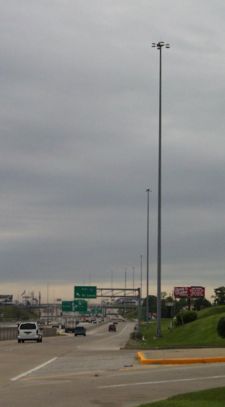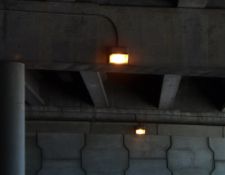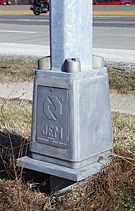901.7 Light Source and Intensity

901.7.1 Light Emitting Diode (LED) Luminaires
LED luminaires are used for fixed source lighting of roadways. Luminaire selection and use are as identified in MoDOT’s standard plans and specifications.
901.7.2 Average Maintained Intensity
The average maintained intensity is the average level of horizontal illuminance on the roadway pavement when the output of the lamp and luminaire is diminished by the maintenance factor.
Continuous lighting installations along freeways, urban arterials, expressways, and ramp connections thereto shall provide an average maintained intensity of 0.6 fc (6.5 lux) and a minimum intensity of 0.2 fc (2.2 lux). Continuous lighting installations on existing roadways, not including freeways, urban arterials, expressways or ramp connections thereto shall provide an average maintained intensity of 0.4 fc (4.3 lux) and a minimum intensity of 0.2 fc (2.2 lux).
Basic lighting at intersections, including ramp terminals at crossroads, shall provide an average maintained intensity of 0.6 fc (6.5 lux) and a minimum intensity of 0.2 fc (2.2 lux) within the limits of the intersection.
The approach noses of all divisional islands and channelizing islands with non-mountable curbs shall be lit to a minimum intensity of 0.2 fc (2.2 lux) on the vertical face of the island. Guidance for lighting of typical island noses is available.
Examples of lighting configurations are shown in Fig. 901.1.2 Basic Lighting for Signalized Interchange, Channelized Intersections, and Roundabouts, Fig. 901.2.1 Basic Lighting for Unchannelized/Unsignalized Intersections and Fig. 901.7.2 Typical Lighting for Signalized Intersections.
Guidance showing the limits for various mounting heights and luminaire sizes for direct reflectance and silhouette discernment lighting is available. Proper lighting of island noses may also dictate mounting height and luminaire size in an intersection. Mixing silhouette discernment and direct reflectance lighting is not recommended. If an intersection contains one or more divisional islands or channelizing islands with non-mountable curbs, all luminaires are to be located for direct reflectance lighting.
Basic lighting at interchanges provides an average maintained intensity of approximately 0.6 fc (6.5 lux) or more in the areas lit. Examples of interchange lighting are shown in Fig. 901.1 Basic Lighting at Diamond Interchanges, Fig. 901.2 Directional Interchanges and Fig. 901.3 Cloverleaf Interchanges. Areas of potential vehicle conflict including exit gore areas, the ends of acceleration lanes, ramp merges, ramp diverges, weaving areas, ramp terminal intersections, etc. are to be lit.
Guidance is available for luminaire locations for typical on and off ramps to maintain required intensities.
High mast lighting in complex interchanges shall provide an average maintained intensity of 0.6 fc (6.5 lux) and a minimum intensity of 0.2 fc (2.2 lux) on all paved driving surfaces within the interchange. The areas of potential vehicle conflict as described above are lit to a maintained intensity of 0.6 fc (6.5 lux) or higher.
The figures in this article show configurations for many typical situations. For unusual geometrics or lighting conditions, use the ALADAN program, or an equivalent, to determine the lighting layout and illumination levels.
901.7.3 Uniformity
The uniformity ratio is the ratio of average footcandle (lux) of illuminance on the pavement area to the footcandle (lux) at the point of minimum illuminance on the pavement. Continuous lighting must provide a uniformity ratio of 4:1 or better for 45 ft. mounting heights and 6:1 or better for 30 ft. mounting heights. Spacing of luminaires based on this criteria is found in EPG 901.11 Light Emitting Diode (LED) Luminaire Performance and Computation of Roadway Illumination.
901.7.4 Adaption (Transition) Lighting
Adaptation lighting attempts to reduce the rapid and extreme changes in illuminance when travelers enter or leave a continuously lighted section of roadway. Adaptation lighting is also used to adapt the driver to continuous interchange lighting before important decision points. The value of adaptation lighting is debatable since it is difficult to attain a gradual uniform change. Adaptation lighting is recommended for the extremities of a continuous lighted section of roadway 1 mile or more long or complex interchanges that are continuously lit. The transition effect is attained by decreasing the intensity of the last few luminaires, rather than by using increased spacing. Typically, the transition section is 15 seconds in length and the average intensity is approximately 50 percent of the intensity in the continuously lit section.
901.7.5 Underpass Lighting

Underpass Luminaires. Underpass luminaires are 150 watt high pressure sodium (HPS) units with integral 24-0 or 480-volt ballasts for wall mounting outdoors.
Underpasses over 75 ft. long, measured at right angles to the structure, are lighted with underpass luminaires when necessary to maintain the continuity of existing or proposed lighting. If roadway lighting units positioned near each portal provide sufficient light to penetrate the underpass and maintain the same intensity of illumination or uniformity ratio as is used on the approach roadways, the underpass luminaires are not used.
901.7.6 High Mast Lighting
High mast lighting is principally used at complex interchanges and lights a large area by a group of luminaires mounted in a fixed orientation at the top of a tall mast, generally 80 ft. or taller. The district must authorize high mast lighting. The request for high mast lighting conceptual approval is to be included with the lighting warrants. Data supporting the selection of pole height, pole location and type of luminaires is to be included with the preliminary lighting plan. Where high mast lighting is used at complex interchanges, adaptation lighting is recommended for each section where vehicles enter and leave the interchange.
The district is responsible for all bid items associated with high mast lighting and to design the foundation and the structure above the foundation for inclusion in the project plans.
901.7.7 Luminaire Mounting Heights
LED-A luminaires are mounted 30 ft. above the pavement. LED-B and LED-C luminaires are mounted 45 ft. above the pavement. Requests for mounting heights other than 30 or 45 ft. will be coordinated with Highway Safety and Traffic.
901.7.8 Location of Luminaires and Poles for 30 ft. Mounting Height
Luminaires are mounted 30 ft. above the edge of travelway and within 3 ft. of the edge of travelway to best utilize available light. Lighting poles have a 28 ft. shaft length and an 18 in. bracket rise. The 30 ft. mounting height of the slip-fitter above the edge of travelway is attained by means of adjusting the bracket mounting plates on the shaft.
Type AT (ground-mounted) poles have breakaway features. Shafts do not require handholes since splices are performed in the transformer base. Poles behind guardrail, installed for purposes other than protection of lighting poles, are installed in accordance with Standard Plan 606.00.
Type B (bridge-mounted) poles on bridge safety barrier curbs of 2 ft. 8 in. height will result in a 30 ft. mounting height above edge of travelway. Consult with Bridge to coordinate design details.
Poles mounted on structures other than bridge safety barrier curbs, such as retaining walls, require special lengths.
901.7.9 Location of Luminaires and Poles for 45 ft. Mounting Height
Luminaires are mounted 45 ft. above the edge of travelway and no farther than 5 ft. horizontal from the edge of travelway unless clear zone requirements dictate otherwise. If the clear zone exists, observe the following:
- If the clear zone is 20 ft. or narrower, the pole is to be located so the luminaire is no more than 5 ft. from the edge of travelway
20 ft. maximum - 15 ft. bracket arm = 5 ft. maximum setback
- If the clear zone is wider than 20 ft. and less than or equal to 30 ft., the pole is to be located so the luminaire is no more than 15 ft. from the edge of travelway
30 ft. maximum - 15 ft. bracket arm = 15 ft. maximum setback
Where right of way is sufficient, lighting poles located on the outside of the roadway are to be placed outside the clear zone, but no farther than 30 ft. from the edge of travelway in order to maintain an effective utilization of the light source. Poles are to be located at a uniform distance from the roadway. Lighting poles located on the outside of ramps are to be placed a maximum of 20 ft. from the edge of the ramp’s driving lane. See Figure 901.7.5 for luminaire locations at on- and off-ramp areas. Lighting poles located adjacent to auxiliary lanes are placed no farther than 30 ft. from the nearest edge of the through lane. Lighting poles have a bracket rise of 5 ft. 6 in. The 45 ft. mounting height of the slip-fitter above the edge of travelway is attained by means of adjusting the bracket mounting plates on the shaft.

Type AT (ground-mounted) poles have breakaway features. Shafts do not require handholes since splices are performed in the transformer base. Poles behind guardrail, installed for purposes other than protection of lighting poles, are installed according to Standard Plan 606.00. Shaft lengths are determined from the cross-section at each pole location for pole designs 1 through 5 as shown on the plans.
Type B (bridge-mounted) poles on bridge safety barrier curbs 2 ft. 8 in. tall will result in a 45 ft. mounting height above edge of travelway. Consult with Bridge to coordinate design details.
Type MB (median barrier-mounted) poles on median barrier 2 ft. 8 in. tall will result in a 45 ft. mounting height above edge of travelway. Consult with Bridge to coordinate design details.
Poles mounted on structures other than bridge safety barrier curbs and concrete median barriers, such as retaining walls, require special lengths.
901.7.10 Lighting Poles Located in the Median
Poles are not normally located in the median of a divided highway having an overall pavement and median width up to 100 ft., unless it becomes economically impractical to light the roadway from the outside shoulders. The following instructions apply to urban area roads that cannot be economically lighted from the outside because of the width of multilane pavement to be lighted, and do not apply to divided roadways with two 24 or 36 ft. pavements with a wide median where each pavement may be lighted individually from poles located on the outside shoulders.
Where lighting poles are located within a barrier median, the total median width is at least 8 ft., and the width between barrier curbs at least 4 ft. The width between barrier curbs may be less than 4 ft. if the total width of median is more than 8 ft.
A width of 12 ft. for a mountable median is the minimum width for location of lighting poles.
If the guardrail and lighting poles are placed in a median, the lighting pole is located at approximately the midpoint between guardrail posts with the handhole in line with the guardrail. To utilize standard guardrail sections, the lighting pole spacing is in multiples of 6 ft. 3 in. This spacing is measured along the centerline of the guardrail and not along the survey baseline unless the two coincide.
Light pole spacing is to be as close as possible to the calculated theoretical spacing required for the average maintained intensity of light.
Only in exceptional cases can lighting be entirely from poles located in the median, such as depressed roadway with retaining walls or on or behind concrete median barriers because there is better utilization of lumens from lamps located on the outside of wide pavements. For example, when a LED-A luminaire is located above the median edge of a six-lane highway with a 16 ft. median, and a mounting height of 30 ft., 40 percent is utilized. Where the same conditions exist for an installation over the outside edge, 58 percent is utilized. The maximum utilization is 60 percent. Good results are obtained by outside-inside alternating locations with twin bracket arms on the median poles. Underpass luminaires are sometimes mounted on the retaining walls of a depressed roadway.
To summarize: (1) Lighting located on the outside of the roadway is preferred where possible; (2) Alternating poles located outside of the roadway and median poles may be used for traffic ways with more than six lanes each direction provided the median design meets requirements; (3) Depressed roadways with retaining walls may be lighted entirely from median poles, with the same requirements for median design, or from underpass luminaires mounted on the walls.
901.7.11 Signalized Intersections
Lighting will be provided at all signalized intersections. All quadrants of the intersection are to be illuminated whether or not there are islands on all approaches. Lighting at signalized intersections is to provide an average maintained intensity as specified in EPG 901.7.2. If the intersection has raised channelizing islands or divisional islands, the intersection is to be illuminated by direct reflectance (see Figure 901.7.2). The luminaire is to be located in front of the nose of any island in accordance with Figure 901.7.1. For those approaches without raised islands, the luminaire is to be located as if an island existed on that approach. Direct reflectance and signal pole lighting are not to be mixed.
At signalized ramp terminals where basic lighting along the freeway is planned or in place, lighting with separate light poles and conduit systems is recommended.
If the intersection does not have raised islands, the luminaires may be placed on the signal poles to provide silhouette discernment lighting (see Figure 901.7.2). Each quadrant of the intersection is to be illuminated. The luminaires are to be installed directly over the mast arms or cable spans to provide the proper silhouette effect. If the intersection is located within the limits of continuous lighting meeting intensity requirements, the signal pole lighting is not required.
Lighting control for 120-volt signal pole lighting or separate pole lighting is shown on Standard Plan 902.15. If the capacity of this control box is exceeded or if the lighting is part of a larger system, then a 240-volt or 480-volt base-mounted control station is used. Where separate light poles and 240- and 480-volt lighting circuits are used at signalized intersections, the wiring, conduit, pull boxes and lighting control station are to be separated from the signal equipment. It is not desirable to have higher voltage lighting wiring mixed with the 120-volt signal control wiring. Signal and lighting controllers can share a power supply, but separate meters and disconnect switches will be needed (see Standard Plan 902.15).
901.7.12 Control Station and Power Supply
Control stations and power supplies consist of all equipment and materials necessary for the distribution of secondary electrical power. Control station design details are shown on the standard plans or approved special sheets. Secondary voltage is to be provided by the utility, with any utility equipment substation located off of highway right of way.
A letter is required from the utility stating they will provide secondary voltage to the necessary control stations. A copy of this letter is to be forwarded to Design Division.
Two types of lighting control systems are available for use as follows. If other types of control station designs are desired, they are to be submitted to Design for approval.
901.7.12.1 240-Volt and 480-Volt Four-Circuit Lighting Control Stations. These control stations are base-mounted as shown on Standard Plan 901.30. These control stations also require a Type 1 or Type 2 power supply as shown on Standard Plan 901.80. These power supplies can also supply power for signal controllers.
These control stations are to be used with interchange lighting, continuous lighting and tower lighting systems. These control stations are also used with intersection lighting where the capabilities of the 120-volt control box described below are exceeded. Lighting and signal conduit systems are separate with 240- or 480-volt lighting systems. For installations requiring different voltages for lighting and signal applications, either two preformed pull boxes or one double concrete pull box, Type B, shall be used. Contractors may use the double concrete pull box, Type B, instead of two preformed pull boxes.
901.7.12.2 Power Supply with 120-Volt Lighting Control Box. This system incorporates a small lighting control box on a Type 1 or Type 2 power supply assembly as shown on Standard Plan 902.15. With this system, lighting wiring can be incorporated into signal conduit systems.
This system is to be used for lighting at both signalized and unsignalized intersections. This system can be used at intersections with signal pole lighting or separate lighting poles under the following conditions:
- Lighting cable sizes are no greater than #8 AWG (10 mm2).
- No more than 6 – LED-A luminaires, 6 – LED-B luminaires, or 4 – LED-C luminaires.
- No more than six 2c. - #12 (2c. - 4 mm2) cables or eight 1c. - #8 (1c. - 10 mm2) cables.
If any of these conditions are exceeded, the 240-volt, 4-circuit control station is to be used.